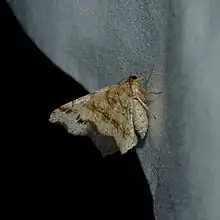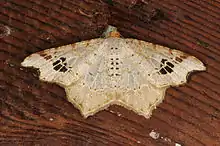| Macaria aemulataria | |
|---|---|
 | |
 | |
| Scientific classification | |
| Domain: | Eukaryota |
| Kingdom: | Animalia |
| Phylum: | Arthropoda |
| Class: | Insecta |
| Order: | Lepidoptera |
| Family: | Geometridae |
| Genus: | Macaria |
| Species: | M. aemulataria |
| Binomial name | |
| Macaria aemulataria Walker, 1861 | |
| Synonyms[1] | |
| |
Macaria aemulataria, the common angle moth, is a moth in the family Geometridae. The species was first described by Francis Walker in 1861.[2] It is found from Nova Scotia to Florida, west to Texas, north to Oregon and Alberta.[3]
The wingspan is 20–22 mm (0.79–0.87 in). The forewings are cream-grey with three transverse lines and a bold brown patch in the middle outer third. The hindwings have a discal spot and antemedian and postmedian lines. Adults are on wing from mid-June to mid-July in Alberta and from May to September in Ohio.
References
Wikimedia Commons has media related to Macaria aemulataria.
Wikispecies has information related to Macaria aemulataria.
- ↑ Savela, Markku (ed.). "Macaria". Lepidoptera and some other life forms. Retrieved 16 February 2021 – via FUNET.
- ↑ "910750.00 – 6326 – Macaria aemulataria – Common Angle Moth – Walker, 1861". North American Moth Photographers Group. Mississippi State University. Retrieved November 10, 2020.
- ↑ McLeod, Robin (October 11, 2018). "Species Macaria aemulataria - Common Angle - Hodges#6326". BugGuide. Retrieved November 10, 2020.
- ↑ Anweiler, G. G. (May 3, 2004). "Species Details Macaria aemulataria". University of Alberta Museums. E.H. Strickland Entomological Museum. Retrieved November 10, 2020.
This article is issued from Wikipedia. The text is licensed under Creative Commons - Attribution - Sharealike. Additional terms may apply for the media files.